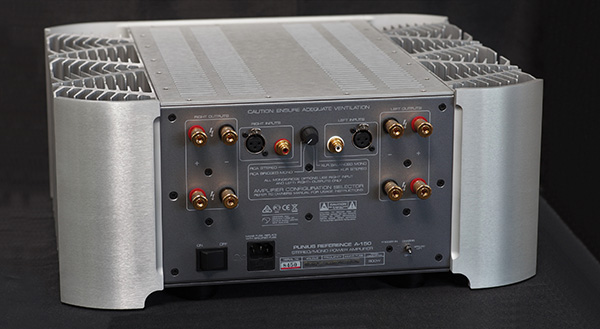| Columns Retired Columns & Blogs |
There are only 8 ohms in both modes and bridged. But have you measured it on 4 ohms too?

When was the last time I'd encountered a Plinius product? I found no talk of the 40-year-old New Zealand brand between a brief mention in a 2015 column by John Marks and 2022, when Robert Schryer spied a Plinius component at the Montréal Audio Fest. The most recent Stereophile review of a Plinius component was Erick Lichte's 2011 take on the SA-103 power amplifier, in which he concluded, "The Plinius SA-103 offers a natural, neutral tonal balance, just the right amount of musicality, superb bass performance, plenty of current to drive the most piggish speakers, functional and tasteful design. It is (dare I say it) a good value at its price, considering its performance."
Under the auspices of Ralph Abramo and California-based Plinius Audio Sales and Repair, Plinius's US profile seems to be rising again.
The Reference A-150, which Plinius refers to as the RA-150, isn't especially new. It was released in 2019, but it took a while to gain a substantial presence in the US market. One notable feature: It is bridgeable for use as a powerful monoblock. When so bridged, its rated power more than doubles; see below for details.
When I first communicated with Abramo, he had a single RA-150 available for review. After I mentioned my current status as a serial monoblock reviewer, he offered to send a second RA-150 a bit later, once the second amplifier had accumulated a couple hundred hours of break-in time.
In consultation with Editor Jim, I decided to do something unique in my reviewing history (footnote 1). First, I'd listen to a single RA-150 in stereo via its balanced inputs. When the second amp arrived, I'd switch to balanced, bridged mode using the two RA-150s as monoblocks and compare the sound of stereo to mono. Why I've never done this before, only my hairdresser knows for sure.
Technical details
Abramo supplemented information in the manual via email messages and phone calls. The predecessors to the RA-150 and its top-of-the-line big brother, the RA-300, designated "SA," were designed by the late Gary Morrison more than 20 years ago. Each had a quasi-complementary output section; all the transistors were NPN (footnote 2). In contrast, the Reference RA series, designed by Karl Willoughby, has a true complementary output section using matched NPN and PNP transistors. Abramo says this allows for more power output and delivers current faster to the output stage, faster transients, and better bass response.
In stereo, the RA-150 is rated to deliver 150Wpc into 8 ohms and 250Wpc into 4 ohms. Using a pair of RA-150s in bridged-mono is said to up the power output to 450Wpc into 8 ohms, 600Wpc into 4 ohms. A rotary switch located between XLR and RCA inputs on the amp's rear panel enables users to choose one of four settings: RCA stereo, RCA bridged mono, XLR stereo, or XLR balanced mono. Operating in XLR balanced mono, Plinius says, the Reference A-150 is a true balanced monoblock amplifier.

The RA-150 has a feature that's rare: A button on the front panel allows you to switch between "class-AB" and "class-A" settings (footnote 3). Plinius says that the class-A setting "provides class-A bias to the output stage therefore ensuring the optimum performance of the amplifier during all listening events" and avows that "a well-designed class-A circuit has inherently lower distortion than any other design" and that in class-A operation, "there is an absence of power supply modulation common in class-AB amplifiers." The manual calls class-AB "a bias configuration used by the majority of high fidelity amplifiers," which "produces very high quality sound, suitable for all occasions where critical listening is not a priority."
As John Atkinson observed in last month's review of the Accuphase A-300, for an amplifier with this much power to operate solely in class-A—to stay in class-A all the way up to its full rated power—"would be impractical" because the heatsinks would need to be too large. As Abramo confirmed, set to class-AB, the amplifier operates in class-A up to some unspecified low power. Set to class-A, it operates in class-A up to some much higher power—also unspecified, although 50W was mentioned casually as the likely class-A/class-AB threshold. With 50W of pure class-A and reasonably sensitive speakers, most music will be reproduced in class-A, all but very loud, complex peaks.
Like any other powerful amplifier, when operating in class-A, the RA-150 runs hot. Plinius says that in class-A operation, the amp consumes "approximately 1000 watts, similar to a small electric heater." (footnote 4) It goes on to note, accurately, that class-AB allows an amplifier to run cooler and use less electricity, especially when it is turned on and music isn't playing.
States the company: "You will find that the Plinius Reference A-150 will become noticeably 'purer' in sound after being on for a period of time. We recommend waiting at least 24 hours before expecting the best quality of sound reproduction from your amplifier." Plinius also states that switching from class-AB to "class-A" operation requires only a few minutes of additional warm-up.
To further conserve electricity and lower costs, the RA-150 has a power-saving "Ecologic Control" that automatically switches from class-A to class-AB after a half-hour of nonuse. This control can be reconfigured internally to switch after 15, 30, or 60 minutes without music playing, but you'll need to open the case, which means removing and replacing 14 screws.

The Plinius Reference amplifiers include a rectifier for each rail, which allows the addition of more capacitors in the power supply, for "faster" operation. "The four capacitors in the corners of the amp on each rail provide instantaneous response, as they are placed as close as possible to the output transistors," Abramo explained. "The new design also has higher rail voltage, which increases the available current and wattage. It also has a more refined driver stage, where the low input signal is amplified, so you match the impedance to the power amplifier input buffer stage, and this contributes to a lower noisefloor. Precision DC regulators help clean up any residual AC that remains in the line stage's power supply. There are no coupling capacitors between the stages; it's all direct coupled. Direct coupling allows the amplifier to go down to DC levels and necessitates a DC protection circuit. Bypass capacitors are Audience AuriCap XO. All these things make for a better sounding amplifier [that] reveals minor details and harmonics in the music."
At the RA-150's heart lies a 1100VA transformer. Its driver-stage power supply contains Nichicon Gold Standard low-ESR (equivalent series resistance) capacitors. Those Nichicon capacitors, which are polypropylene, "quickly release power upon demand." The RA-150 has 72,400µF of capacitance.
What you see/what to do
On the center of the front panel, beneath the Plinius logo, sits a small, unobtrusive blue LED. When the RA-150 is plugged in and the rear-panel power switch is switched on, the LED flashes until completion of a short initialization sequence; when the power is on, it's a steady blue. If electronic errors should occur, the LED will again start flashing. During the review period, the RA-150s functioned flawlessly.
Lower down on the front panel are two buttons, side by side, above which sit two very small white LEDs. The Mute button on the left is especially useful for switching interconnects on the fly, because Mute disconnects the speaker outputs. When the amplifier first powers up, it automatically goes into Mute mode. Pressing the Mute button takes it out of mute, turns off the LED, and allows you to begin listening.
The right button, labeled "Class A," is for choosing between class-A and class-AB operation. In class-A, the LED lights. If I forgot to switch to class-AB after a listening session, the amp's "Ecologic Control" reverted to class-AB a half-hour after I departed. The rear panel includes two pairs of speaker binding posts to facilitate biwiring (footnote 5), and one set each of RCA and XLR input jacks. Between them lies the previously discussed "amplifier configuration selector." A power toggle switch, 15A IEC connector, remote trigger socket (for integration into a home theater/multimedia system; I didn't use it), and a ground-lift toggle switch complete the back-panel layout.
The ground-lift toggle switch has two positions: ground lift and chassis ground. States the manual, "In some installations a hum loop may exist due to duplicate ground paths from different equipment. Use this switch to remove the connection from 0V to ground thus allowing some flexibility in your particular set-up, although when using Balanced XLR inputs, the ground lift switch should always be set to 'chassis.'" Through experimentation, I learned that if you don't switch to "chassis" when using XLR cables, hum is present at levels impossible to ignore.
Footnote 2: See eeeguide.com/quasi-complementary-push-pull-amplifier.
Footnote 3: The Gryphon Essence monoblock, which I reviewed in the December 2020 issue, also has a class-A/class-AB switch. The Gryphon Apex Stereo, which Michael Fremer reviewed in 2022, has a three-position bias switch.
Footnote 4: After consulting with Plinius engineers, Abramo added that class-AB consumes 92Wpc compared to class-A's 485Wpc.
Footnote 5: For biwiring in a mono setup, care must be taken to only use the red, positive binding posts.

There are only 8 ohms in both modes and bridged. But have you measured it on 4 ohms too?

Shame that it's massive near 40kg weight doesn't reflect in it's current ability into low impedances like normal true complimentary NPN/PNP push pull bi-polar amps can. EG:JC1's, Agostino, Krell ect etc
A little lame in it's current ability into the low impedances of the Alexia, hence the "bass was a mite wooly" sound description by Jason into the Alexia's, even though it has nice low output impedance .012ohm?
Cheers George

Seems like a lot of juice and hassle for an amp that is just very good